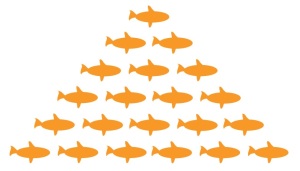Reproducibility is the ability of an entire experiment or study to be reproduced, either by the researcher or by someone else working independently. It is one of the main principles of the scientific method and relies on ceteris paribus. Wikipedia
I was going to start this post with a similar statement in my own words, but couldn’t resist the chance to quote Latin. It always makes you sound so smart. But regardless of whether these are a Wikipedia author’s words or my own, the point is the same – one of the foundations of good science is the ability to reproduce the results.
My work for the neuroimaging project involves developing a process for researchers in this field to cite their data in such a way that makes their work more easily reproducible. The current practice of citing data sets alone doesn’t always make reproducibility possible. A researcher might take different images from a number of different data sets to create an entirely new data set, in which case citing the previous sets in whole doesn’t tell exactly which images are being used. Thus, this gap can make the final research harder to replicate, as well as more difficult to review. We think that we may have a way to help fix this problem and that’s what I’ve been working on for the past few months.
At the same time, I’ve been working on a systematic review with the members of the mammography study team. This work has me locating and reading and discussing a whole slew of articles about the use of telephone call reminders to increase the rate of women receiving a mammogram within current clinical guidelines. It also has me wondering about the nature of clinical research and the concept of reproducible science, for in all of my work, I’ve yet to come across any two studies that are exactly alike. In other words, it doesn’t seem to be common practice for anyone to repeat anyone else’s study. And I can’t help but wonder why this is so.
I imagine it has something to do with funding. Will a funding agency award money to a proposal that seeks to repeat something; something unoriginal? Surely they are more apt to look to fund new ideas.
Maybe it has to do with scientific publishing. Like funding agencies, publishers probably much prefer to publish new ideas and new findings. Who wants to read an article that says the same thing as one they read last year?
Of course, it may also be that researchers look to improve on previous studies, rather than simply repeat them. This is what I see in all of the papers I’ve found for this particular systematic review. The methods are tweaked from study to study; the populations differ just a bit, the length of time varies, etc. It makes sense. The goal of this body of research is to determine what intervention works the best and in changing things slightly, you might just find the answer. What has me baffled about this process, though, is that as we continue to tweak this aspect or that aspect of a study’s methodology, when and/or how do we ever discover what aspect actually works and then put it into practice?
Working on this particular review, I’ve collected easily 50+ relevant articles, yet as we pull them together – consolidate them to discover any conclusions – the task seems, at times, impossible. Too often, despite the relevancy of the articles to the question asked, what you really end up comparing is apples to oranges. How does this get to the heart of scientific discovery? How does it influence or generate “best practice”? I can’t help but wonder.
Yesterday, during my library’s monthly journal club, we discussed an article that had been recommended reading to me by one of the principal investigators on the mammography study. How to Read a Systematic Review and Meta-analysis and Apply the Results to Patient Care, is the latest User’s Guide on the subject from the Journal of the American Medical Association (JAMA). It prompted a lively session about everything from how research is done, to how medical students are taught to read the literature, to how the media portrays medical news. I recommend it.
Of course, there are many explanations to my question and many factors at play. My wondering and our journal club discussion doesn’t afford any concrete solution and/or answer, still I feel it’s a worthwhile topic for medical librarians to think about. If you have any thoughts, please keep the discussion going in the comments section below.

Dumb question: is your journal club for librarians or interprofessional?
It’s for us – the librarians.
Could not have come at a better time.
Long story short…rehired as a part-time librarian at a health science library…after the position was abolished 4 years ago.
Have some catching up to do, this will help!
Congratulations on your new gig, Janice, and best of luck!